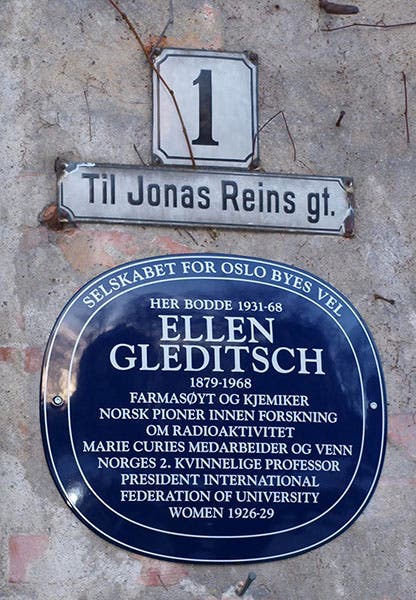Scientist of the Day - Ellen Gleditsch
Ellen Gleditsch, born Dec. 29, 1879, in Mandal, Norway, was the first – and for a long time the only – Norwegian radiochemist. Fascinated by reports of developments in the new field of radioactivity, she sought first-hand experience in 1907 by going to Paris, where the Curie lab controlled the mother lode of radium. Gleditsch spent five years working alongside the recently widowed Marie Curie. An important part of her research concerned the relationship of uranium to radium – whether the two occurred together as a matter of coincidence, or because the one gave rise to the other. Over the same five years she earned a licentiate, the equivalent of a master’s degree in science, from the Sorbonne. In Norway, she had trained as a pharmacist. As the eldest of eleven children in a middle-class family, she well understood the need to earn her own living.
Gleditsch returned to Kristiana (as Oslo was then known) in 1912, determined to establish a research school and laboratory of radioactivity at the University. She taught the country’s first courses in that subject and attracted students by her skill as a teacher. In the spring of 1913, however, both her parents and her brother August died within weeks of one another, and she assumed responsibility for raising her youngest sibling, Kristian, age twelve. She set up housekeeping with him and another brother, Adler, who was twenty. Living with two younger brothers gave Ellen all the burdens of marriage and childcare without the benefit of a husband. Nevertheless, she managed to continue her career.
In autumn 1913, having secured funding, she spent a year at Yale University with American chemist Bertram Boltwood. They got off to a rough start, as indicated by Boltwood’s letter of 12 September to physicist Ernest Rutherford in Manchester:
“Mlle. Gleditsch has written that she has a fellowship of the American Scandinavian Foundation (I never heard of it before!), and wishes to come and work with me in New Haven!! What do you think of that? I have written to her and tried to ward her off, but as the letter was necessarily delayed in forwarding to me, I am afraid she will be in New York before I get there. Tell Mrs. Rutherford that a silver fruit dish will make a very nice wedding present!!!”
Over the course of that year, Gleditsch arrived at a definitive value for the half-life of radium – a crucial constant that made it possible to estimate the much longer half-life of uranium, not to mention the age of the earth. (Her radium figure, between 1,642 and 1,674 years, closely approximates the currently accepted value of 1,600.) Gleditsch also traveled around the northeastern United States to lecture at several women’s colleges, and received an honorary doctorate from Smith.
During the First World War, Marie Curie invited Gleditsch back to Paris to fill in for members of her lab who were fighting at the front. Gleditsch accepted, despite the dangers of travel, and supervised the production of radium at the Curie-affiliated factory in Nogent-sur-Marne for six months.
In 1916 Kristiana University offered her an associate professorship in radiochemistry and atomic theory. Her rise to full professor in 1929 proved contentious, at least partly because she was only the second woman to achieve that rank. The time she had spent abroad also worked against her, in the view of some provincial colleagues, but made her all the more valuable to the International Federation of University Women, which she had joined soon after its founding in 1919. In 1926 the IFUW elected her its president.
Gleditsch continued traveling widely to observe techniques at other centers, such as the Cavendish Laboratory at Cambridge and the Radium Institutes in Vienna and Berlin. On her home turf, her collaborators sometimes included her sister Liv, who helped her define the atomic weights of lead and chlorine.
During World War II, though already in her sixties, Gleditsch assisted the resistance in German-occupied Norway. One of her capers found her moving about the countryside, purportedly sewing national costumes, while in fact delivering secret messages. She also found places in her department for two Jewish colleagues forced to leave Austria.
After her retirement in 1946, Gleditsch wrote popular science biographies of several chemists and promoted scholarships for women to study abroad. In 1962 she accepted an honorary doctorate from the Sorbonne – the first one ever awarded to a woman by that university.
“I have dangerously many interests beside my science,” she once told an alumni group. “I enjoy fiction, theater, and music, although not cinema….I love sports and outdoor life, am a member of the Female Students’ Skiing Club, and know no better kind of summer holiday than a sojourn in the Norwegian mountains. I have lived long enough in France to appreciate that cooking is a great and important art, and I am known in many countries for my omelets.”
Her health remained good through her eighty-eighth year, which is nothing short of remarkable, given her early and extensive exposure to radium. She died June 5, 1968, at her country home in Enebakk, of a stroke, having outlived all her fellow radio-activists.
Dava Sobel is the author of Longitude, Galileo’s Daughter, and, most recently The Glass Universe. She is writing a new book about the women who worked in Madame Curie’s lab.








